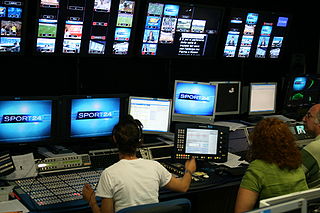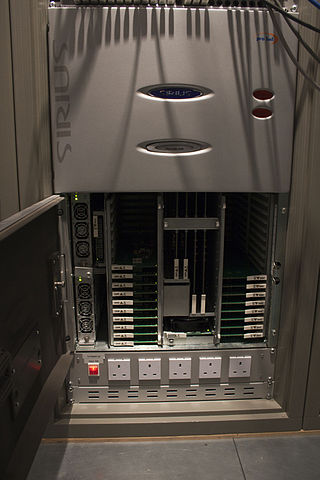Genlock is a common technique where the video output of one source is used to synchronize other picture sources together. The aim in video applications is to ensure the coincidence of signals in time at a combining or switching point. When video instruments are synchronized in this way, they are said to be generator-locked, or genlocked.

Serial digital interface (SDI) is a family of digital video interfaces first standardized by SMPTE in 1989. For example, ITU-R BT.656 and SMPTE 259M define digital video interfaces used for broadcast-grade video. A related standard, known as high-definition serial digital interface (HD-SDI), is standardized in SMPTE 292M; this provides a nominal data rate of 1.485 Gbit/s.

A professional video camera is a high-end device for creating electronic moving images. Originally developed for use in television studios or with outside broadcast trucks, they are now also used for music videos, direct-to-video movies, corporate and educational videos, wedding videos, among other uses. Since the 2000s, most professional video cameras are digital.

1-inch Type C Helical Scan or SMPTE C is a professional reel-to-reel analog recording helical scan videotape format co-developed and introduced by Ampex and Sony in 1976. It became the replacement in the professional video and broadcast television industries for the then-incumbent 2-inch quadruplex videotape open-reel format. Additionally, it replaced the unsuccessful type A format, also developed by Ampex, and primarily in mainland Europe, it supplemented the type B format, developed by the Fernseh division of Bosch.
Ikegami Tsushinki Co., Ltd. is a Japanese manufacturer of professional and broadcast television equipment, especially professional video cameras, both for electronic news gathering and studio use. The company was founded in 1946.

A vision mixer is a device used to select between different live video sources and, in some cases, compositing live video sources together to create visual effects.

A television studio, also called a television production studio, is an installation room in which video productions take place, either for the production of live television and its recording onto video tape or other media such as SSDs, or for the acquisition of raw footage for post-production. The design of a studio is similar to, and derived from, movie studios, with a few amendments for the special requirements of television production. A professional television studio generally has several rooms, which are kept separate for noise and practicality reasons. These rooms are connected via 'talkback' or an intercom, and personnel will be divided among these workplaces.

The production control room (PCR) or studio control room (SCR) is the place in a television studio in which the composition of the outgoing program takes place.

In a television studio, a tally light is a small signal lamp on a professional video camera or monitor. It is usually located just above the lens or on the electronic viewfinder (EVF) and communicates, for the benefit of those in front of the camera as well as the camera operator, that the camera is live.

A video reference monitor, also called a broadcast reference monitor or just reference monitor, is a specialized display device similar to a television set, used to monitor the output of a video-generating device, such as playout from a video server, IRD, video camera, VCR, or DVD player. It may or may not have professional audio monitoring capability. Unlike a television set, a video monitor has no tuner and, as such, is unable independently to tune into an over-the-air broadcast like a television receiver. One common use of video monitors is in television stations, television studios, production trucks and in outside broadcast vehicles, where broadcast engineers use them for confidence checking of analog signal and digital signals throughout the system. They can also be used for color grading if calibrated, during post-production. Banks of reference monitors are also a common sight on the sets of newscasts, showing internal or external feeds.
Time base correction (TBC) is a technique to reduce or eliminate errors caused by mechanical instability present in analog recordings on mechanical media. Without time base correction, a signal from a videotape recorder (VTR) or videocassette recorder (VCR), cannot be mixed with other, more time-stable devices such as character generators and video cameras found in television studios and post-production facilities.

Asynchronous Serial Interface, or ASI, is a method of carrying an MPEG Transport Stream (MPEG-TS) over 75-ohm copper coaxial cable or optical fiber. It is popular in the television industry as a means of transporting broadcast programs from the studio to the final transmission equipment before it reaches viewers sitting at home.

Eclair, formerly Laboratoires Eclair, was a film production, film laboratory, and movie camera manufacturing company established in Épinay-sur-Seine, France by Charles Jourjon in 1907. What remains of the business is a unit of Ymagis Group offering creative and distribution services for the motion pictures industries across Europe and North America such as editing, color grading, restoration, digital and theatrical delivery, versioning.
In television technology, Active Format Description (AFD) is a standard set of codes that can be sent in the MPEG video stream or in the baseband SDI video signal that carries information about their aspect ratio and other active picture characteristics. It has been used by television broadcasters to enable both 4:3 and 16:9 television sets to optimally present pictures transmitted in either format. It has also been used by broadcasters to dynamically control how down-conversion equipment formats widescreen 16:9 pictures for 4:3 displays.

A video router, also known as a video matrix switch or SDI router, is an electronic switch designed to route video signals from multiple input sources such as cameras, VT/DDR, computers and DVD players, to one or more display devices, such as monitors, projectors, and TVs.

In broadcast facilities and television studios, a central apparatus room, central machine room, or central equipment room (CER), or central technical area (CTA), or rack room is where shared equipment common to all technical areas is located. Some broadcast facilities have several of these rooms. It should be air-conditioned, however low-noise specifications such as acoustical treatments are optional. Equipment is connected either directly with an attached foldout monitor, keyboard and mouse or remotely via KVM switch, SSH, VNC, RS-232 or remote desktop.
Processing amplifier, commonly called ProcAmp, is used to alter, change or clean video or audio signal components or parameters in realtime.

A television production truck or OB van is a small mobile production control room to allow filming of events and video production at locations outside a regular television studio. They are used for remote broadcasts, outside broadcasting (OB), and electronic field production (EFP). Some require a crew of as many as 30 people, with additional trucks for additional equipment as well as a satellite truck, which transmits video back to the studio by sending it up through a communications satellite using a satellite dish, which then transmits it back down to the studio. Alternatively, some production trucks include a satellite transmitter and satellite dish for this purpose in a single truck body to save space, time and cost.

Black and burst, also known as bi-level sync and black burst, is an analogue signal used in broadcasting. It is a composite video signal with a black picture. It is a reference signal used to synchronise video equipment, in order to have them output video signals with the same timing. This allows seamless switching between two video signals.
Link Electronics Ltd. was a major UK industrial and broadcast television equipment manufacturer and systems integrator in the 1970s and 1980s. The company was founded by John Tanner and David Mann, who began manufacturing television cameras in 1966.
















